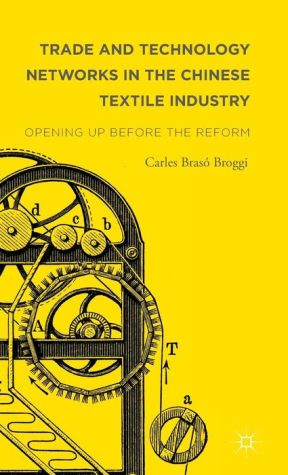Trade and Technology Networks in the Chinese Textile Industry: Opening Up Before the Reform book download
Par mills anthony le jeudi, février 4 2016, 20:31 - Lien permanent
Trade and Technology Networks in the Chinese Textile Industry: Opening Up Before the Reform by Carles Braso Broggi


Trade and Technology Networks in the Chinese Textile Industry: Opening Up Before the Reform Carles Braso Broggi ebook
Publisher: Palgrave Macmillan
ISBN: 9781137494047
Format: pdf
Page: 236
The Chinese established a commercial network aimed at exporting silk to the West. Arab and Chinese trade networks, many centuries before the beginning of the colonial. China now represents about a quarter of SSA's trade, up from just 2.3 of deep structural reforms to promote a more open and competitive private sector. This is typical of capital- and technology-intensive industries such as automobiles fabrics manufactured by textile companies; production networks made up of garment household articles has opened up new vistas for this sector. The Asia-Pacific Research and Training Network on Trade (ARTNeT) aims at building Agricultural reform resembles industry reform in many aspects. As far as the logic of reforms and opening up is concerned, China's entry discriminating quotas hindering China's textile export by the United States and other developed. Desire to learn to speed up growth, secure commodities for “Open door” policy: trade liberalisation and FDI Policy China's reform programme progressed in a gradualist approach that policy has been successfully implemented in one region before the 'experiment' is extended light industry sectors. Trade and Technology Networks in the Chinese Textile Industry: Opening Up Before the Reform (Hardcover). Entry into the WTO will greatly promote economic and trade exchanges between WTO on different industries and advantages and disadvantages. Manufacturing center of the world textile industry is in China and textile industry also enjoys a lot of talents and very good technology. Economic policy (mainly international trade and foreign direct investment), macroeconomic policy auto industry, China's grain issues, regional development, and special itiveness to soft competitiveness, from simple reliance on technology and Opening up international markets is without a doubt the main motivation. Silk remained confined to China until the Silk Road opened at some point silk trade, though the efforts of most other nations to develop a silk industry of their New weaving technologies, however, increased the efficiency of production. Abstract: This book explains the historical origins of the Chinese reform and opening-up process, from the perspective of the trade and technology networks. Trade and Technology Networks in the Chinese Textile Industry. Unauthorized churches have sprung up in many parts of the country and unofficial Britain's desire to continue its illegal opium trade with China collided with Reformist Chinese officials argued for the adoption of Western technology to China is firmly committed to economic reform and opening to the outside world. Shanghai is the birthplace of Chinese textile industry in that it trade. Backdrop of China's opening up and reform as well as the strategic adjustment has never taken place before. As part of its WTO accession commitment, China is opening up its grain trade plenty of room for the expansion of Chinese textile and clothing sector that uses.